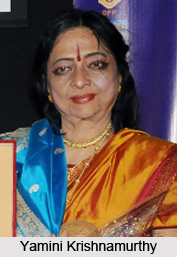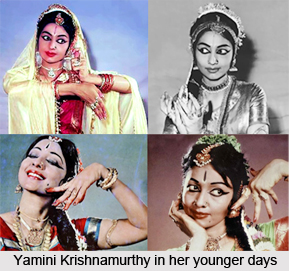 "A dancer must have tremendous personality. A God like Christ and even a godman like Rajneesh had some personality. Combination of talent, dedication, creativity and being emotive is imperative. A coupling of these four qualities with technique is essential. Monotony is deterrent as it regards your style and I notice today, that new dancers perform in a startlingly similar fashion." - Yamini Krishnamurthy.
"A dancer must have tremendous personality. A God like Christ and even a godman like Rajneesh had some personality. Combination of talent, dedication, creativity and being emotive is imperative. A coupling of these four qualities with technique is essential. Monotony is deterrent as it regards your style and I notice today, that new dancers perform in a startlingly similar fashion." - Yamini Krishnamurthy.
Yamini `Poornatilaka` Krishnamurthy alias Yamini Krishnamurthy is a renowned Indian classical dancer who has dedicated her life to Indian classical dance styles Bharatnatyam and Kuchipudi for decades. She is considered as the torch bearer of the Kuchipudi form of dance. She gave her debut with a dance performance in Chennai in 1957, where her charisma and stage presence were discerned when she was only seventeen. She has led an illustrious and eventful dancing career and has been honoured with the Padma Shri, the Padma Bhushan and most recently the Padma Vibhushan, India"s second highest civilian honour, in 2016.
Early Life of Yamini Krishnamurthy
Yamini Krishnamurthy was born on December 20, 1940, in a Telugu family in Madanapalli city in the Chittoor district of Andhra Pradesh. Born on a full moon night, her grandfather named her Yamini "Poornatalika", the term literally meaning "a full mark on the brow of night". She was brought up in Chidambaram, Tamil Nadu. Her mother tongue is Telugu. She hails from an eminent family that is more literally inclined than artistically. Her father, M. Krishnamurthy, was a Sanskrit scholar and grandfather was an expert in Urdu poetry.
At the age of five, she was enrolled as a student of Bharatnatyam in Kalakshetra School of Dance, Chennai under Rukmini Devi Arundale. After acquiring the foundation base at Kalakshetra, she went on to groom herself under renowned masters like Kanchipuram Ellappa Pillai, Thanjavur Kittapa Pillai, Dhandayudhapani Pillai and Mylapore Gouri Amma. She trained in Kuchipudi under Vedantam Lakshmi Narayana Shastri, Chinta Krishnamurthy and Pasumarthy Venugopal Krishna Sharma. In addition to Bharatnatyam and Kuchipudi, she learnt Odissi from Pankaj Charan Das and Kelucharan Mohapatra. She was also trained in Carnatic vocal music by M. D. Ramanathan and in Veena from Kalpakam Swaminathan.
 Career of Yamini Krishnamurthy
Career of Yamini Krishnamurthy
After her debut in 1957 in Chennai, she became one of the most admired dancers in the country by 1960. Her performances brought about national and international recognition to Bharatnatyam and Kuchipudi. She had played a significant role in popularizing Kuchipudi that was then emerging as a solo dance form of Andhra Pradesh. She is a leading exponent of both Bharatnatyam and Kuchipudi and has the honour of being `Asthana Nartaki` (resident dancer) of the Tirumala Tirupati Devasthanam, one of the most sacrosanct temples of India. Her dance has been credited by some critics as the personification of rhythm.
Besides stage performances, Yamini made a 13-episode serial on classical dance, which aired on the Doordarshan. In 1990, she started her own institute "Yamini School of Dance", at Hauz Khas in New Delhi, where she imparts dance lessons to young dancers. She released her autobiography, "A Passion For Dance", which was well received by the readers. Yamini is working on a ballet titled "The Gandhian Order of Life" and another on Tagore and Subramania Bharati and their depiction of the Goddess Kali.
Awards and Honours received by Yamini Krishnamurthy
Yamini Krishnamurthy, in her career and for her contribution in developing and promoting the arena of Indian classical dance, has been honoured with the following awards:
•Padma Vibhushan, India"s second highest civilian honour, for Art - Classical Dance by the Government of India, in 2016
•Padma Bhushan, India"s third highest civilian honour, for Art - Classical Dance by the Government of India, in 2001
•Padma Shri, India"s fourth highest civilian honour, for Art - Classical Dance by the Government of India, in 1968
•Sangeet Natak Akademi Award in 1977
•Natya Shastra award by Shambhavi School of Dance in Bangalore at "Nayika - Excellence Personified", on the occasion of International Women`s Day on March 8, 2014. She gave a lecture demonstration "Contribution of Woman to Kuchipudi" and also released a Kuchipudi Dance DVD featuring Prateeksha Kashi, the daughter of Kuchipudi danseuse Smt. Vyjayanthi Kashi, artistic director of Shambhavi.
Personal Life of Yamini Krishnamurthy
Yamini Krishnamurthy did not marry. She has dedicated her life to her dance school, her students and her compositions. As she asserts, "Marriage did not happen because it was not meant to be. As for children, all my disciples are my children."



















